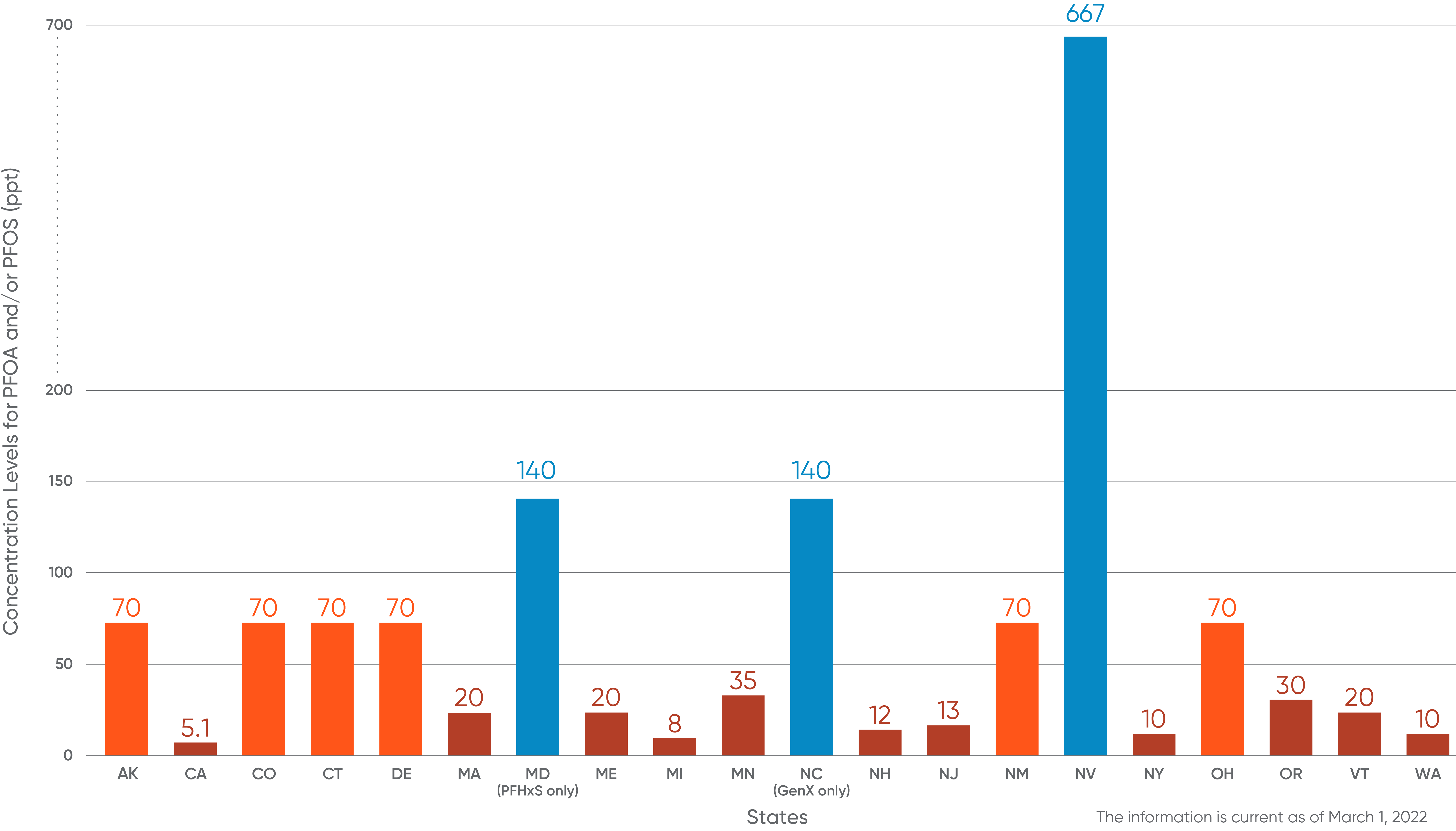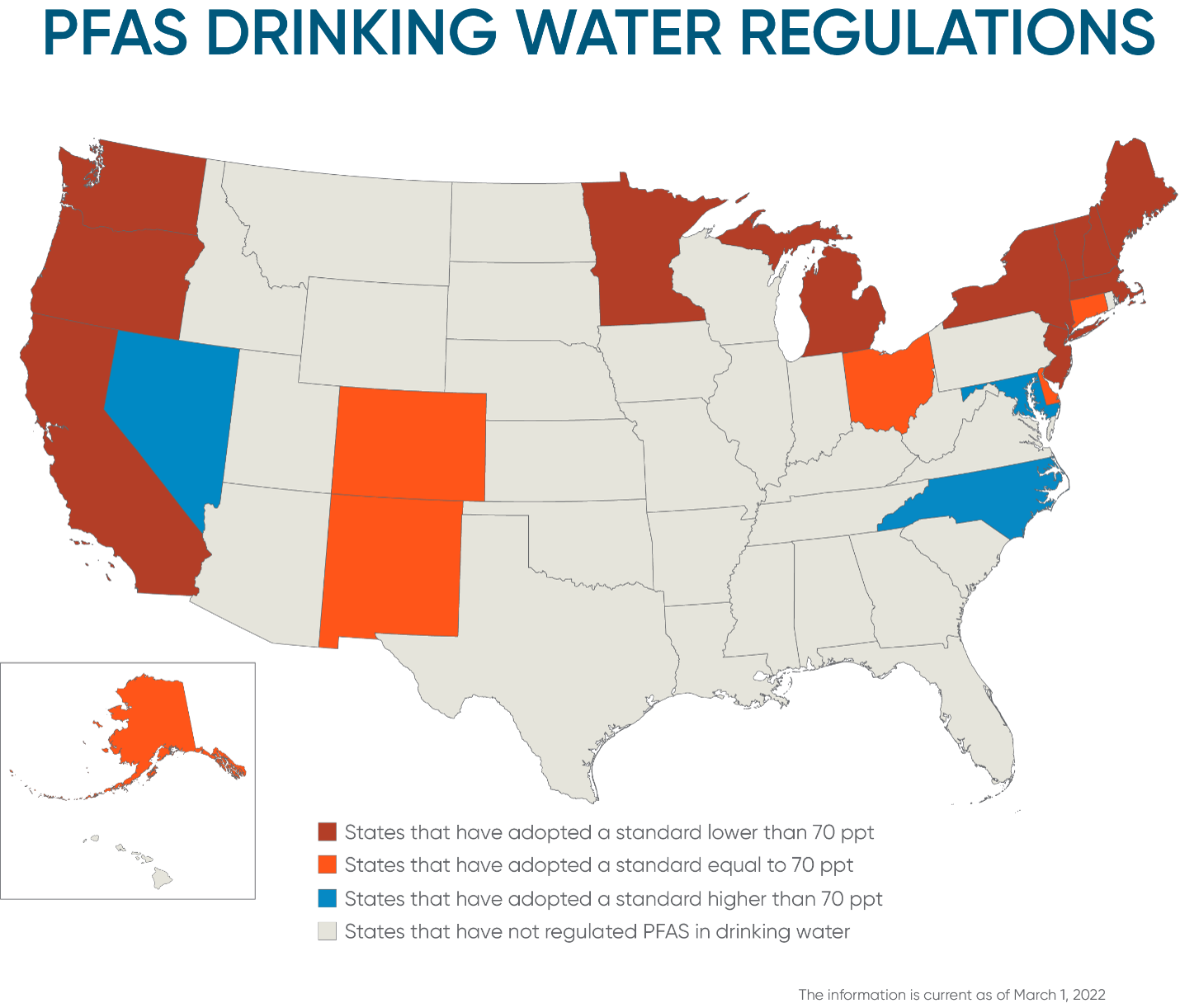Insights
PFAS Update: State-by-State Regulation of PFAS Substances in Drinking Water
Mar 04, 2022This insight was originally published in March 2022. Visit our up-to-date blog on PFAS drinking water standards: state-by-state regulations >
In the absence of an enforceable federal drinking water standard for per- and polyfluoroalkyl substances (“PFAS”), many states have started regulating PFAS compounds in drinking water. The result is a patchwork of regulations and standards of varying levels, which presents significant operational and compliance challenges to impacted industries. This client alert surveys the maximum contaminant levels (“MCLs”), as well as guidance and notification levels, for PFAS compounds – typically perfluorooctane sufonic acid (“PFOS”) and perflurooctanic acid (”PFOA”) – in drinking water across the United States.
I. Federal Health Recommendations and Advisory
The United States Environmental Protection Agency (“EPA”) has issued a Lifetime Drinking Water Health Advisory Level of 70 ppt for PFOS and PFOA. EPA's Health Advisory is non-enforceable, but is intended to provide technical information to state agencies and other public health officials regarding health effects, analytical methodologies, and treatment technologies associated with drinking water PFAS contamination. Numerous states have adopted and/or used EPA’s recommended 70 ppt PFAS concentration limitation for drinking water (e.g., Alaska, Colorado, Connecticut, Delaware, New Mexico, and Ohio).
According to the PFAS Strategic Roadmap, EPA expects to issue proposed drinking water limits, or MCLs, for PFOA and PFOS in the fall of 2023. A national drinking water limit will require the entire country to evaluate the concentration of these two compounds in drinking water, and to implement treatment systems and permit limits to achieve the MCLs.
II. State Regulations
Until the federal government enacts MCLs for PFOA and PFOS, the regulatory landscape for PFAS compounds in drinking water consists of an array of widely-varying state-promulgated standards and regulations. For example, one of the smallest allowable concentrations is 5.1 ppt (California; PFOA only), and one of the largest values is 667,000 ppt (Nevada; PFBS only). For further detail, the chart below illustrates the significance of the discrepancies between the regulatory levels for PFOA and/or PFOS.

The map and chart below are current as of March 1, 2022. Two states, including Pennsylvania (MCLs for two PFAS substances) and Rhode Island (Interim Drinking Water Standards for six PFAS substances), have proposed, but not yet promulgated, drinking water regulations for PFAS. Additionally, Delaware, Maine, and Virginia have enacted legislation to establish MCLs for PFAS compounds for drinking water, so implementing regulations in those jurisdictions may be forthcoming. Moreover, Wisconsin is currently involved in an administrative process to establish drinking water standards. These proposals underscore that state-driven guidance and requirements surrounding the PFAS drinking water regulations are developing quickly throughout the country.

|
Participating States |
Concentration Level |
Type of Regulation |
Adoption Status |
|
California |
5.1 ppt |
PFOA (Notification) |
|
|
Michigan |
6 ppt |
PFNA (MCL) |
|
|
California |
6.5 ppt |
PFOS (Notification) |
|
|
Michigan |
8 ppt |
PFOA (MCL) |
|
|
Washington |
9 ppt |
PFNA (Notification) |
|
|
Washington |
10 ppt |
PFOA (Notification) |
|
|
New York |
10 ppt |
PFOA and PFAS (MCL) |
|
|
New Hampshire |
11 ppt |
PFNA (MCL) |
|
|
New Hampshire |
12 ppt |
PFOA (MCL) |
|
|
New Jersey |
13 ppt |
PFNA and PFOS (MCL) |
|
|
New Jersey |
14 ppt |
PFOA (MCL) |
|
|
Minnesota |
15 ppt |
PFOS (Guidance) |
|
|
New Hampshire |
15 ppt |
PFOS (MCL) |
|
|
Washington |
15 ppt |
PFOS (Notification) |
|
|
Michigan |
16 ppt |
PFOS (MCL) |
|
|
New Hampshire |
18 ppt |
PFHxS (MCL) |
|
|
Massachusetts |
20 ppt (Stated in the regulation as 20 ng/L) |
6 PFAS substances combined: PFOA, PFOS, PFHxS, PFNA, PFHpA, and PFDA (MCL) |
|
|
Vermont |
20 ppt (Stated in the regulation as 0.00020 mg/L) |
5 PFAS substances combined: PFOA, PFOS, PFHpA, PFHxS, and PFNA (MCL) |
|
|
Maine |
20 ppt (stated in the Interim Drinking Water Standard as 20 ng/L) |
6 PFAS substances combined: PFOA, PFOS, PFHxS, PFNA, PFHpA, and PFDA (Notification) |
|
|
Ohio |
21 ppt |
PFNA (Guidance) |
|
|
Oregon |
30 ppt |
4 PFAS substances combined: PFOS, PFOA, PFHxS, and PFNA (Guidance) |
|
|
Minnesota |
35 ppt |
PFOA (Guidance) |
|
|
Minnesota |
47 ppt |
PFHxS (Guidance) |
|
|
Michigan |
51 ppt |
PFHxS (MCL) |
|
|
Washington |
65 ppt |
PFHxS (Notification) |
|
|
Connecticut |
70 ppt |
5 PFAS substances combined: PFOS, PFOA, PFHpA, PFHxS, and PFNA (Notification) |
|
|
Colorado |
70 ppt |
3 PFAS substances combined: PFOS, PFOA, and PFNA (Guidance) |
|
|
Alaska, Delaware, New Mexico, and Ohio |
70 ppt |
Adopt the EPA Standard: PFOS and PFOA combined (Notification and Guidance) |
Alaska: Action Level Delaware: Guidance Policy New Mexico: Toxic Pollutant Standard |
|
Ohio |
140 ppt |
PFHxS (Guidance) |
|
|
Maryland |
140 ppt |
PFHxS (Guidance) |
|
|
North Carolina |
140 ppt |
GenX or HFPO-DA (Guidance) |
|
|
Washington |
345 ppt |
PFBS (Notification) |
|
|
Michigan |
370 ppt |
Gen X or HFPO-DA (MCL) |
|
|
Michigan |
420 ppt |
PFBS (MCL) |
|
|
California |
500 ppt (Stated in the regulation as 0.5 ppb) |
PFBS (Notification)
|
|
| Nevada |
667 ppt (stated in the regulation as .667 µg/L) |
PFOA and PFOS (Guidance) |
|
|
Colorado |
700 ppt (Stated in the regulation as 700 ng/L) |
PFHxS (Guidance) |
|
|
Ohio |
700 ppt |
Gen X or HFPO-DA (Guidance) |
|
|
Minnesota |
2,000 ppt |
PFBS (Guidance) |
|
|
Minnesota |
7,000 ppt |
PFBA (Guidance) |
|
|
Ohio |
140,000 ppt |
PFBS (Guidance) |
|
|
Colorado |
400,000 ppt (Stated in the regulation as 400,000 ng/L) |
PFBS (Guidance) |
|
|
Michigan |
400,000 ppt |
PFHxA (MCL) |
|
|
Nevada |
667,000 ppt (stated in the regulation as 667 µg/L) |
PFBS (Guidance) |
No regulations:
Alabama, Arizona, Arkansas, Florida, Georgia, Hawaii, Idaho, Illinois, Indiana, Iowa, Kansas, Kentucky, Louisiana, Mississippi, Missouri, Montana, Nebraska, North Dakota, Oklahoma, Pennsylvania, Rhode Island, South Carolina, South Dakota, Tennessee, Texas, Utah, Virginia, West Virginia, Wisconsin, and Wyoming
Key:
|
Notification |
A corporate representative must inform an appropriate state official that a drinking water concentration in a water source owned or operated by the corporation (public well, supply tank, etc.) is above the limit. A water supply system also may have to inform its customers if there are any samples that exceed the PFAS values. |
|
Guidance |
The state establishes recommended concentration limits for one or more PFAS substances, but no notification or other action is required if concentrations exceed the recommended limits. |
|
MCL |
MCLs establish the maximum amount of a PFAS compound that can be present in drinking water. Treatment facilities that supply drinking water must ensure that these limits are met by treating and filtering the drinking water, and also by limiting the discharge of PFAS compounds through permits. |
III. How Do These Limits Impact Businesses?
MCLs set the maximum concentration of a given contaminant that can be present in drinking water. Publicly owned treatment works (“POTWs”) and drinking water systems are ultimately responsible for meeting the applicable MCLs and are required to ensure that drinking water distributed to the public meets these limits. In order to do that, POTWs and state agencies often include discharge limits in the permits of upstream dischargers to the POTW or other drinking water systems to ensure that the effluent the treatment facility receives can be adequately filtered and treated to comply with the MCLs.
Businesses that currently or historically have used PFAS compounds, or have reason to believe that they may be present in their process wastewater effluent, should evaluate the following considerations:
- Whether their wastewater discharges, following treatment by the POTW or other treatment facilities, are eventually released to sources that are used for drinking water;
- Whether their discharge contains any of the PFAS compounds that are regulated in their jurisdiction; and
- Whether they are likely to be subject to permit conditions limiting the allowable concentration of PFAS compounds in their wastewater discharges.
Acquiring this information will allow businesses to determine whether they need to modify their operations to reduce or eliminate PFAS from their waste stream to achieve compliance with an existing standard, or in anticipation of likely future permit conditions.
IV. Conclusion
The regulation of PFAS substances in drinking water will continue over the next several years as additional research is conducted on potential health impacts, and as regulators at both the federal and state levels develop a deeper understanding of the prevalence of PFAS compounds in drinking water and the efficacy of different MCLs.
For more information on PFAS chemicals, and the regulatory and liability risks that they pose, please visit our PFAS webpage. If you have a question about how to manage PFAS risk in any jurisdiction, contact Tom Lee, John Kindschuh, Elyse Voyen, or any other member of our PFAS team at Bryan Cave Leighton Paisner LLP.
Related Practice Areas
-
Environment
-
PFAS Team




